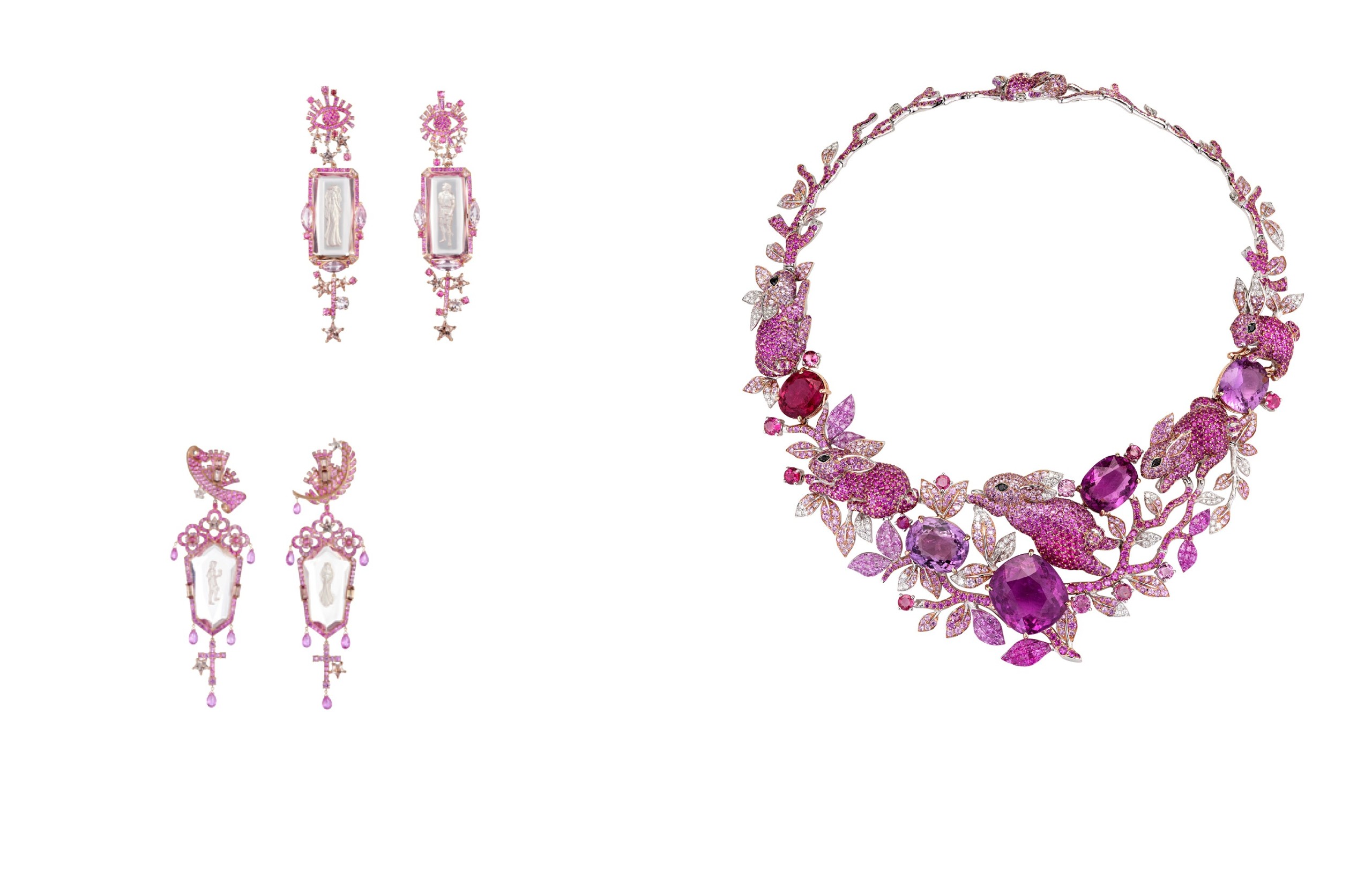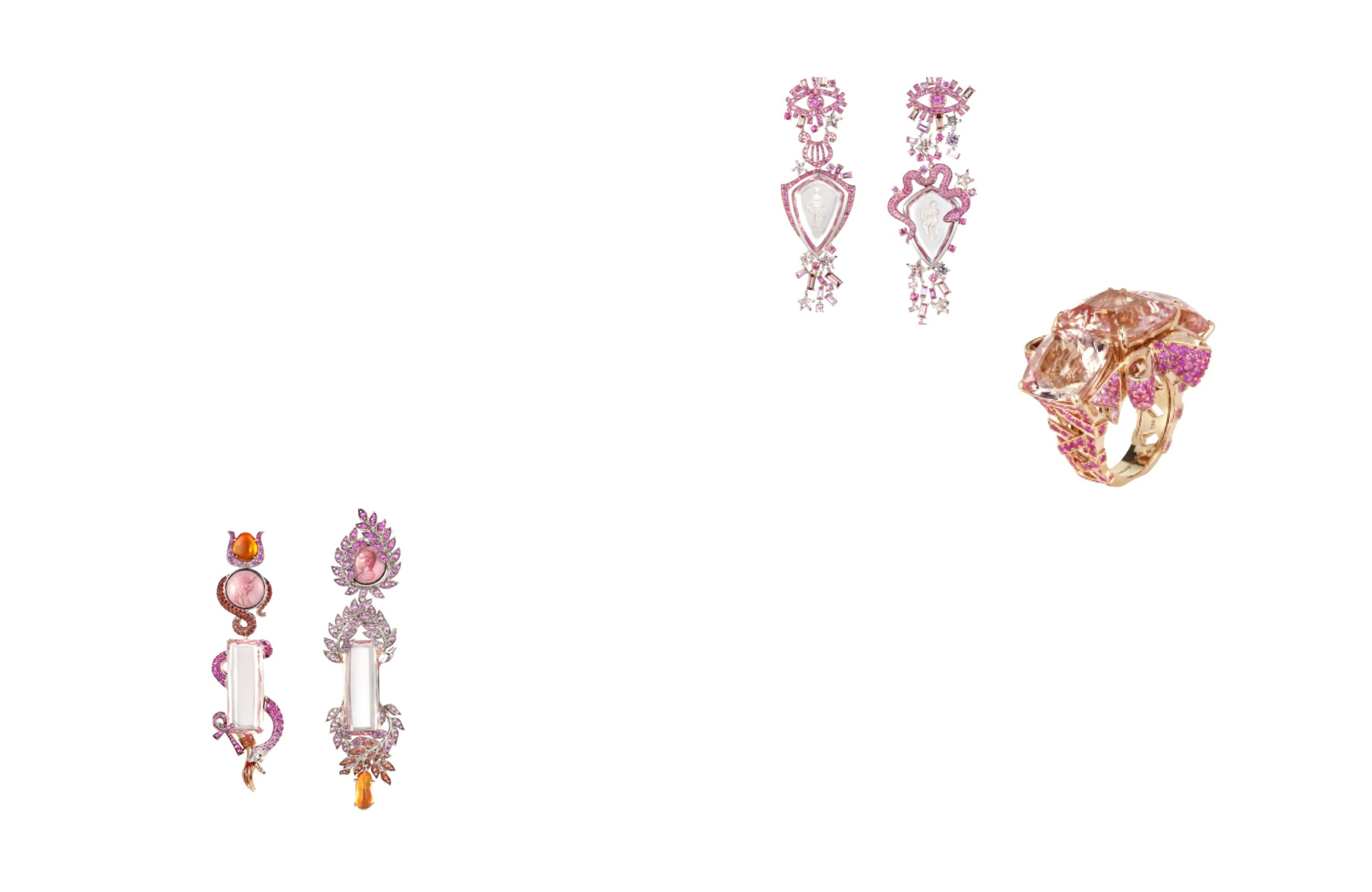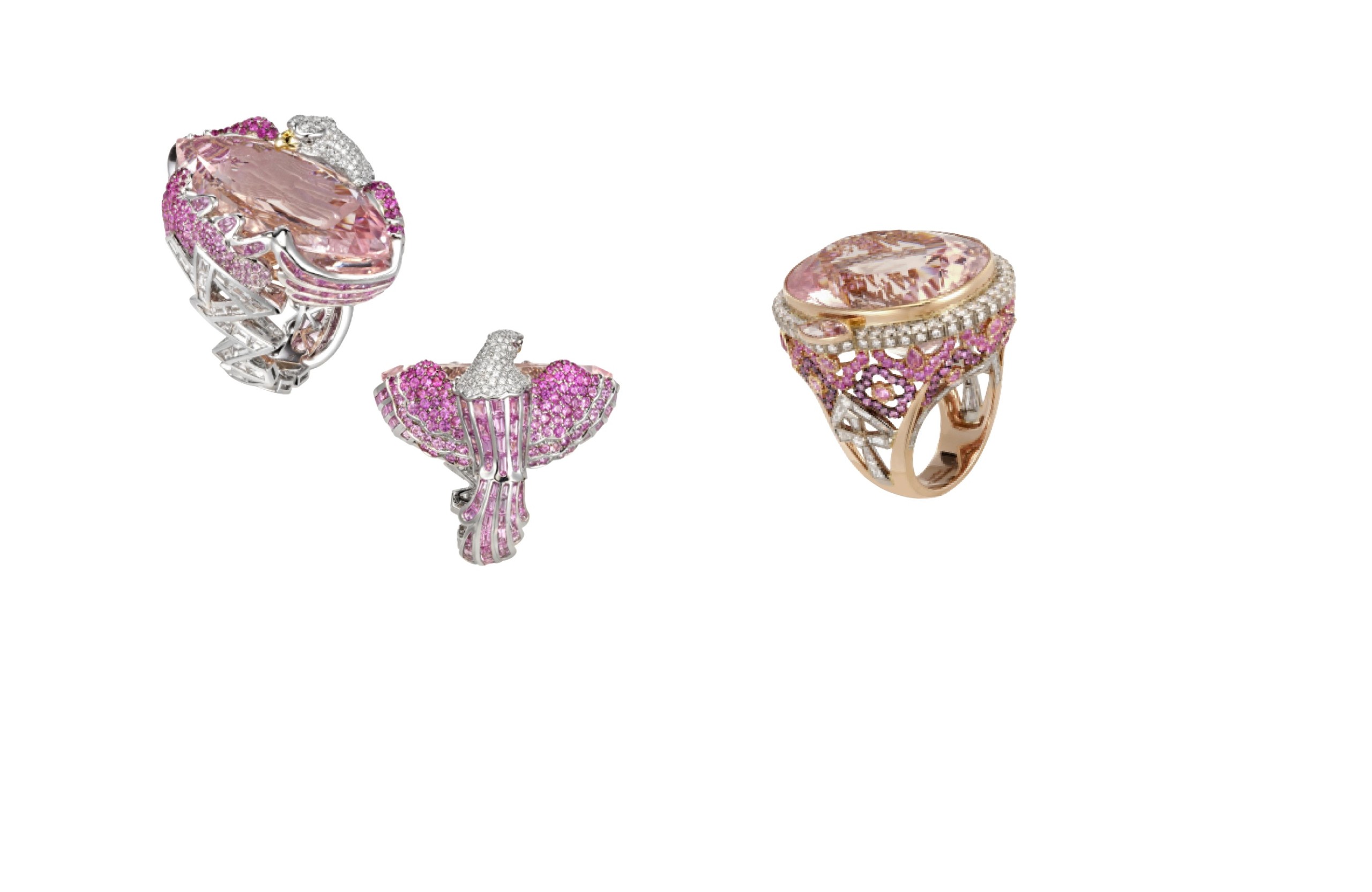
love story
A symbol of eternal love; a precious memory of historical love stories; fire of gemstones that have kept secrets of forbidden romances; sentimental language of gems; passionate lovers separated by distance or death. What could exactly represent all the nuances of these feelings? What is the best way to depict all details – literature, painting or jewellery art? Fascinated by these enigmatic inspirations Lydia Courteille fell in love again and again with gems, jewels and stories. This is the beginning of long and romantic story as a High Jewellery Collection: LOVE STORY by Lydia Courteille.

Credits: Tristan And Isolde Earrings 18k white gold - 48.82gr; 2 morganites - 50.48cts; pink sappihre - 23.63cts; ruby - 0.3cts. lydiacourteille.com
TRISTAN and ISOLDE
The Celtic legend, Tristan and Isolde was written in the 12th century. This passionate story beyond adultery and death, between fidelity and great feelings of bravery, characterizes the fatal hold of love! The hero Tristan goes to Ireland to ask the hand of the princess Isolde for his uncle, King Mark of Cornwall. On their return both of them mistakenly drink a love potion prepared for the King and fall deeply in love with each other. After escape and many adventures, they make peace with the King Mark, who ends marries Isolde. The distraught Tristan goes to Brittany, where he marries another noble woman also named Isolde. When he is wounded by a poisoned arrow, he sends for the first Isolde. His jealous wife tells him that his true love has refused to come; he dies just before she arrives, and she dies in his arms. The story of Tristan and Isolde has inspired many poets, crystallizing the magic of a love reinforced by adultery and which remains indestructible after the lovers' death. Various art forms from the medieval era represented Tristan's story, from ivory mirror cases to the 13th-century Sicilian Tristan Quilt. In addition, many literary versions are illuminated with miniatures. The legend also became a popular subject for Romanticist painters of the late 19th and early 20th century.
HELOISE and ABELARD
Lovers who offended the codes of the 12th century to achieve the highest and deepest points of their feelings. Héloïse was a renowned "woman of letters“, a philosopher of love and friendship, as well as an eventual high-ranking abbess in the Catholic Church. Her erudite and sometimes erotically charged correspondence is the Latin literature basis and serves alongside Abelard's « Historia Calamitatum » as a model of the classical epistolary genre. Her influence extends on later writers such as Chrétien de Troyes, Geoffrey Chaucer, Madame de Lafayette, Thomas Aquinas, Choderlos de Laclos, Voltaire, Rousseau and Simone Weil. Peter Abelard is best known for his passionate tragic love affair, and intense philosophical exchange, with his brilliant student and eventual wife, Héloïse. He was a defender of women and of their education. After having sent Héloïse to a convent in Brittany to protect her from her abusive uncle who did not want her to pursue their forbidden love, then he was castrated by men sent by this uncle. Still considering herself as his spouse even though both retired to monasteries after this event, Héloïse publicly defended him when his doctrine was condemned by Pope Innocent II and Abelard was therefore considered, at that time, a heretic. The story of Abelard and Héloïse has proved immensely popular in modern European culture. This story is known almost entirely from a few sources: first, the Historia Calamitatum; secondly, the seven letters between Abelard and Héloïse which survived (three written by Abelard, and four by Héloïse).

Cleopatre And Marc Antoine: ear pendants transformable into 2 pendants- 18k gold - 52,58gr; 2 enamel portraits; ruby - 0.02ct; orange sapphire-1.66cts; pink sapphire- 5.06ct; fire opal 5.29cts; morganite- 31,79cts. Orpheus and Eurydice Ear Pendants: 18k white gold - 57.92gr; 2 morganite intailles 43.32cts; pink sapphire 22.97cts; ruby 0.32 cts. lydiacourtille.com
CLEOPATRA and MARC ANTOINE
The union that symbolizes love and war passion of two personalities who marked history. The attraction of Marc Antoine and Cleopatra, their loyalty through hardship and time, cultural differences, and their common thirst for conquests. Firstly divine Cleopatra forged an alliance and a sexual relationship with Caesar for placed herself on the throne of Egypt. After that religious propaganda declared Cleopatra the New Isis or Aphrodite - mythic goddess of love and beauty, in Rome. After Caesar’s death Cleopatra had a culmination of her love affairs - marriage with Marc Antoine. Apart from their undoubted mutual affection, Cleopatra needed Marc Antoine in order to revive the old boundaries of the Ptolemaic kingdom Marc Antoine was a Roman general. On a mission to Egypt to question Cleopatra about her loyalty, he became her lover. He returned to Rome to settle differences with Octavian and to strengthen his position where he agreed to marry Octavian’s sister Octavia. When relations with Octavian collapsed again, he headed for Syria and sent for Cleopatra for aid. Octavian sent Octavia to him, and, when Marc Antoine ordered her back to Rome, a fatal breach opened. He divorced Octavia, and Octavian declared war on Cleopatra. Antony lost the Battle of Actium, leading him and Cleopatra to flee to Egypt, pursued by Octavian. When resistance became futile, they committed suicide, Cleopatra by means of an asp bite.
ORPHEUS and EURYDICE
The story of Eurydice and Orpheus is the most famous love story in Greek Mythology – the hero descend to hell to find his beloved. Orpheus and Eurydice got married and were living a happy life until tragedy happened. Eurydice was bathing naked in the river, when a satyr tried to rape her. She tried to avoid him and fell into a nest of vipers and was fatally bitten. Orpheus found his wife's body and due to his grief, started singing the most mournful songs. The nymphs and the gods started weeping upon hearing Orpheus' songs, and advised him to go to the Underworld to bring his wife back. Orpheus indeed followed their advice and met with the god of the Underworld Hades and his wife Persephone. He pleaded to let him take his wife back, and after singing to them, their hearts were softened so much that they agreed. However, they told him not to look back until they both had reached the surface. They started walking their way back; when Orpheus reached the opening of the cave with his wife following, he looked back, anxious to see if Eurydice was behind him. As she had not yet reached the opening doors though, she disappeared back into the Underworld forever.

LEDA and The SWAN BRACELET pink gold 18k - 123.85 grs, morganite intalle of Leda and the Swan – 354 cts, 1590 pink sapphires 58.03 cts, 2 black sapphires, white diamonds 0.55 ct. lydiacourteille.com
LEDA and THE SWAN
One of the last discovery in the ruins of Pompeii was an erotic fresco depicting the Greek goddess Leda - wife of the king of Sparta Tyndare - with a Swan who is none other than the God of the gods on Olympus, Zeus, transformed himself into the bird. One of the masterpiece that connected the previous collection La Vie en Rose is a bracelet with a pink gold swan hovering over the mirror of morganite on which Leda appears, carved from the back of the gemstone. In Greek mythology as told by Homer, Zeus changed into a swan to better seduce Leda during a nocturnal visit. After a night of love two children were born, Pollux and his twin, the famous Helen of Troy, both born after the hatching of an egg spawned by the Spartan Goddess. The story told by Ovid «The Metamorphoses » is a book written at the beginning of the first century, which relates the transformations of gods and men into animals or plants – including the mortal Leda, queen of Sparta, was loved by the god Zeus.

JUPITER and GANYMEDE
Ganymede’s myth is more than a simple story. It is yet another piece in the history of ancient sexuality, with particular importance for queer history. If the king of the gods was allowed to have a male lover, then this certainly suggests a lot for the people adhering to that religion. Ganymede’s myth indicates that erotic relations between individuals of the same sex were at the very least tolerated. Ganymede was a young man from Troy. His beauty was unparalleled and for that reason, Jupiter transformed himself into an eagle. He brought Ganymede to Olympus to serve as his cupbearer and lover. Ganymede’s myth is an important step in the history of homosexuality. Ganymede’s myth was especially popular amongst the Greeks and the Romans. The first recorded mention of Ganymede is found in Homer’s Iliad dating back to the 8th century BCE. Other notable sources include Hesiod, Pindar, Euripides, Apollodorus, Virgil, and Ovid.
HISTORICAL LOVE STORIES
How could a jewelry piece resemble a real love artefact ? What is the look of love? How historical love jewelry looks like? It looks like the High Jewellery Collection LOVE STORY by Lydia Courteille. The real couples and love affairs recreated in jewelry masterpieces.
